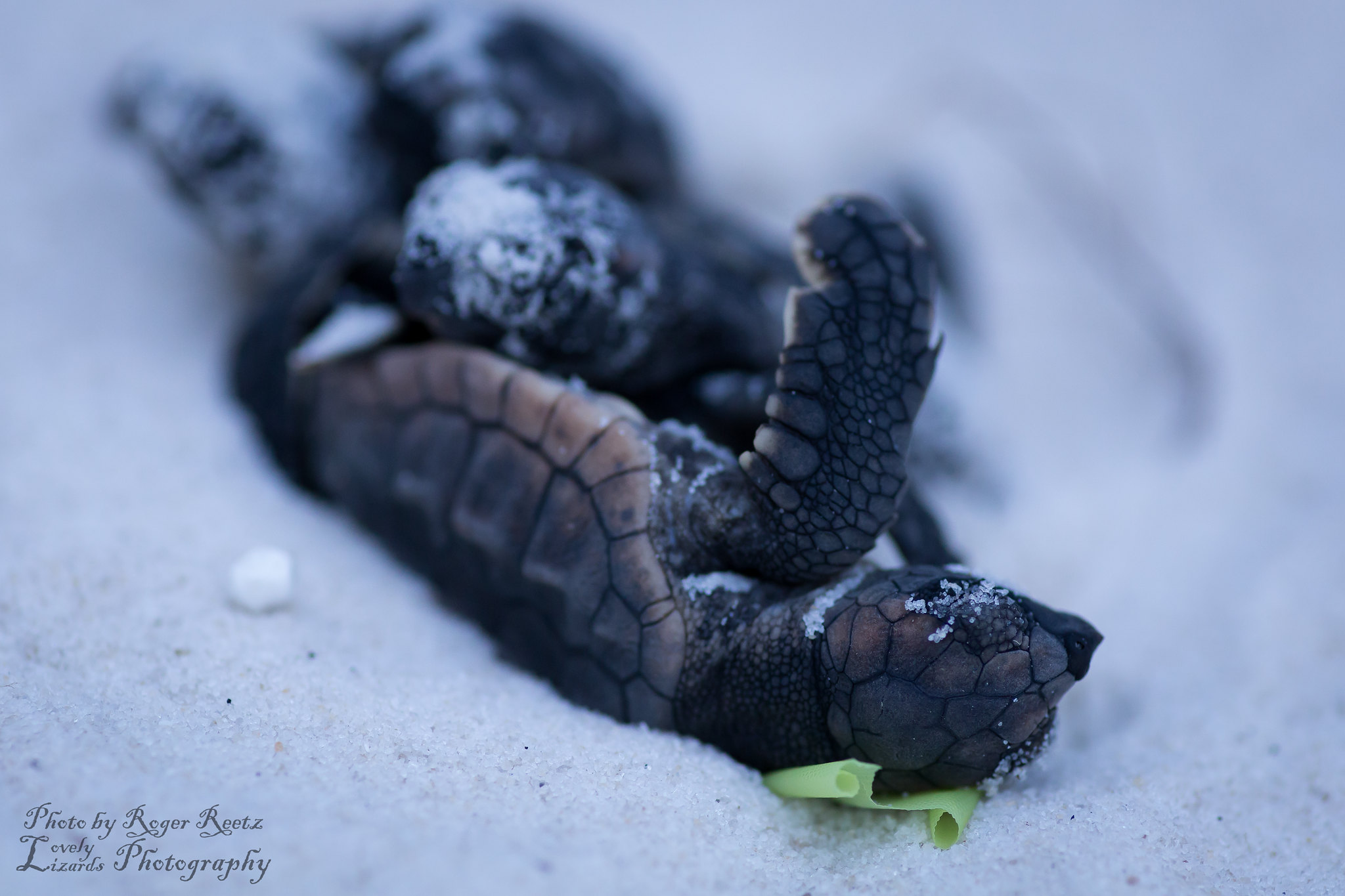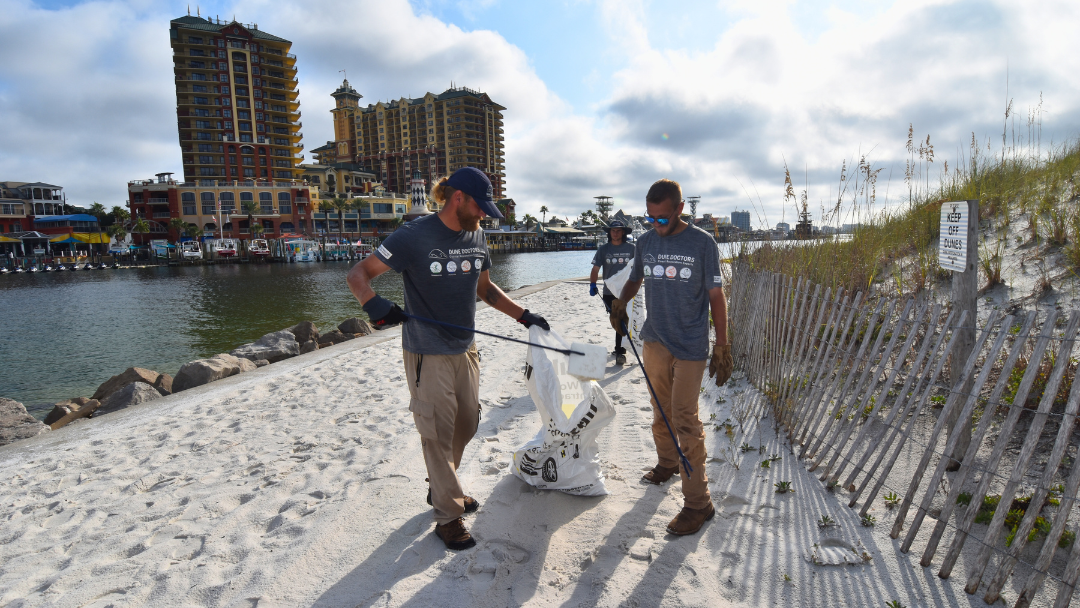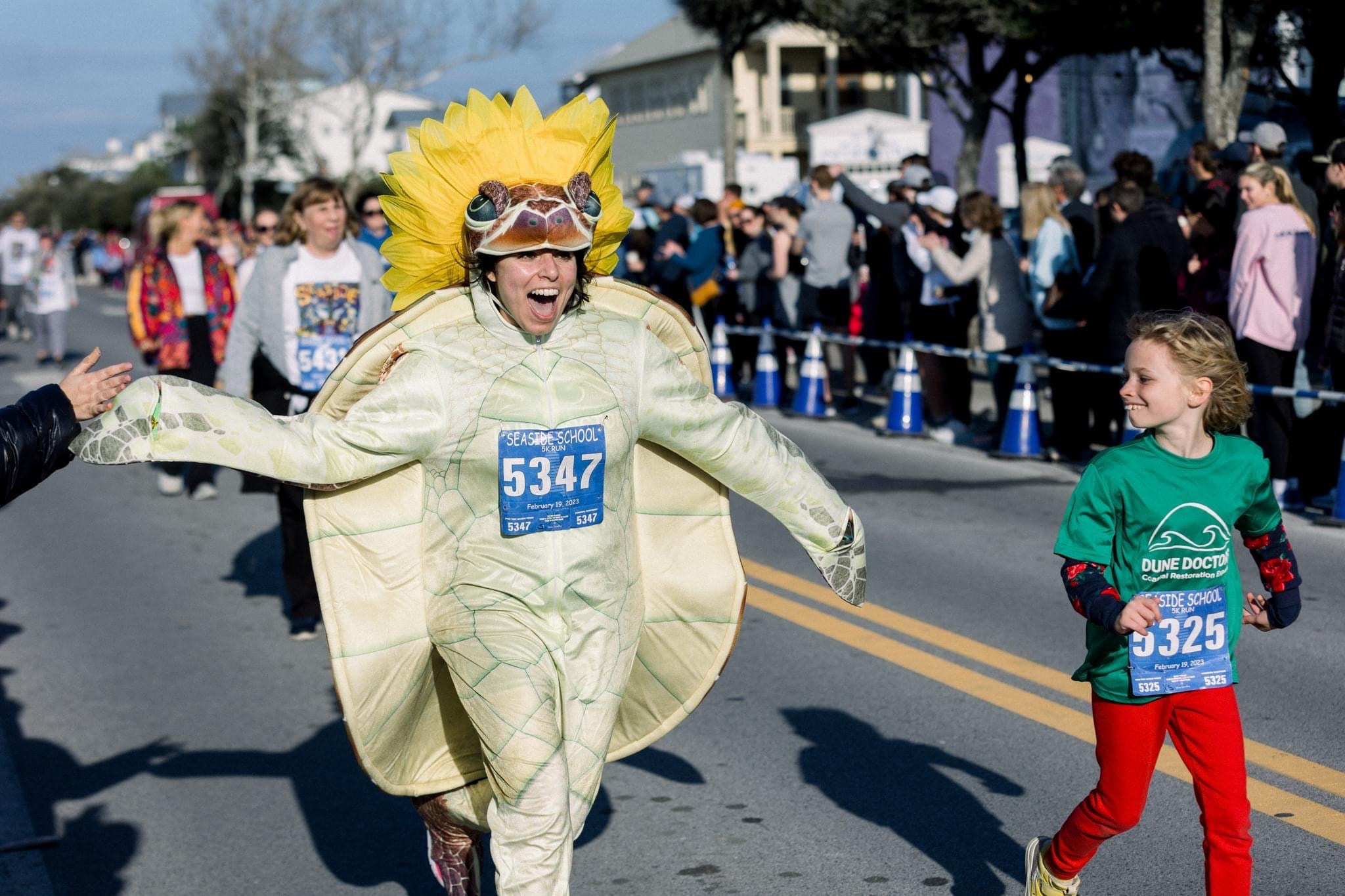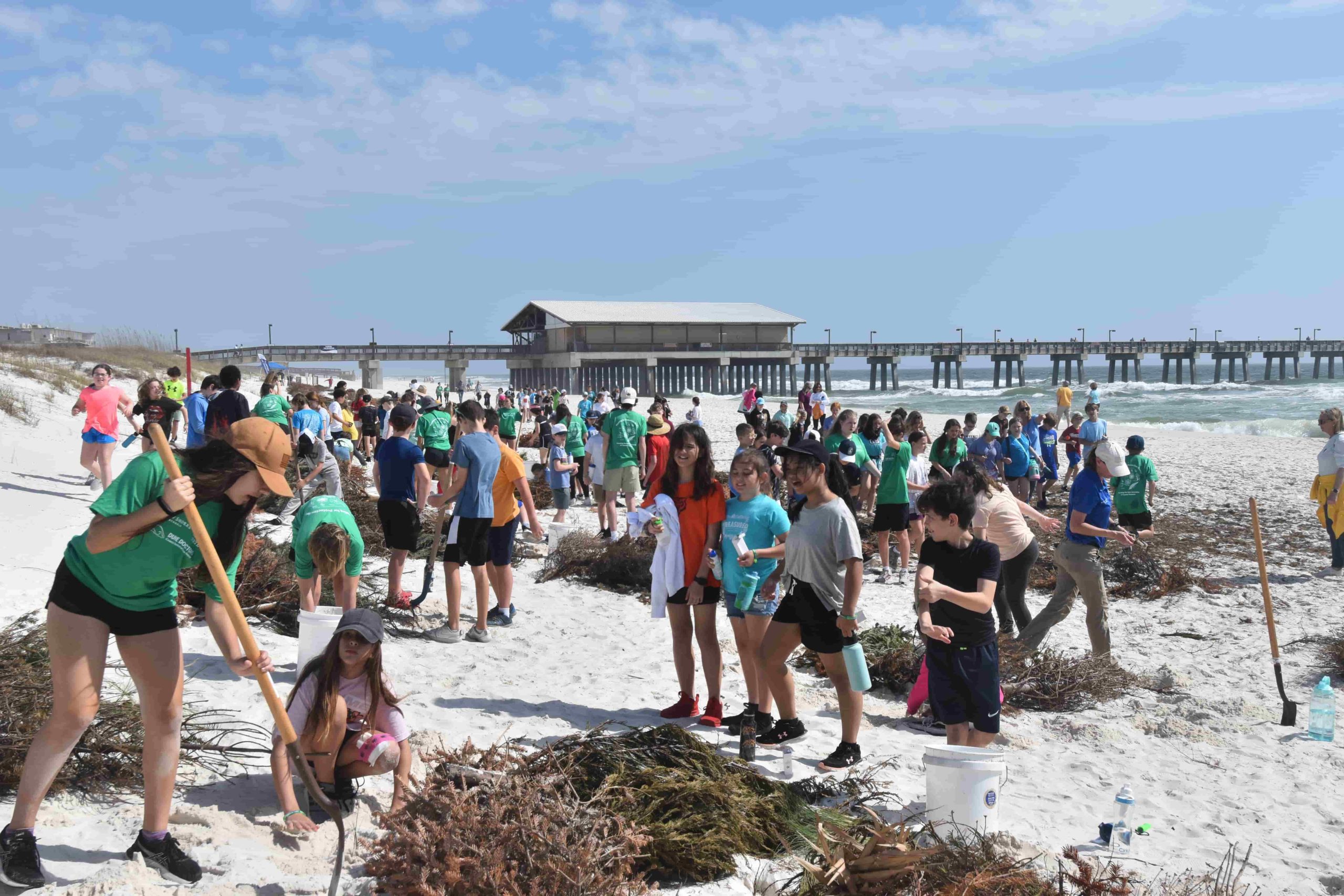
It’s Time for a Sea Turtle Baby Shower!
Mid-July, from beneath the sand all along the Florida and Alabama coast, hatchlings (baby sea turtles) began their journey to adulthood. Witnessing the turtles emerge from their nests and scurry to the water is a bucket-list experience for most beach lovers. With all the strength they can muster, the babies will have to brave enormous odds before finding safety in the open ocean. Relying on their sheer volume for protection, the hatchlings move in unison to overwhelm predators who lurk nearby. Those hatchlings who successfully make it to the crashing surf will have to swim long distances to make it past the coast. In the open water of the Sargasso Sea (an area of the Atlantic Ocean off the east coast), safety lies in free-floating seaweed. These island-like masses of algae function as nurseries in which the hatchlings can mature into adulthood. But, only a few will survive this dangerous journey. This is why we should do our best to provide safe passage for these hatchlings.
How Long Does the Incubation Period Last?
Buried out of the tide’s reach, thousands of sea turtle nests, from five different species, line the coast of Florida and Alabama. According to an in-depth Q&A provided by the Sea Turtle Conservancy, the average incubation takes 60 days and varies by species. During incubation, sand temperature greatly impacts two important aspects of embryo development. First, it dictates the speed of the process. The higher the sand temperature surrounding the eggs, the shorter the incubation periods. Second, the temperature of the sand impacts the ratio of the sex of the hatchlings. Cooler temperatures yield clutches (a group of eggs) with a higher male count while warmer temperatures tend to produce more females.
After Incubation Comes Digging!
Once incubation is complete, the hatchlings break out of their eggs using a temporary tooth called the caruncle located on the edge of their mouth. The eggshell has a soft, leathery texture and is roughly the size of a ping-pong ball. After hatching, the baby turtles remain under the sand for a number of days. During this time, the first few to exit their eggs, stimulate the others to do the same. According to SEE Turtles, before the babies can surface, each hatchling absorbs the remaining yolk attached to its umbilical cord. The yolk, an essential source of nutrients, is vital in providing the newly-hatched sea turtles with the necessary energy to dig, crawl, and swim their way offshore.
What Can You Do to Help the Hatchlings?
In order to achieve higher odds of survival, the hatchlings climb out of their nest in groups and huddle under the surface until the temperature of the sand cools. Cooler sands typically indicate that it is nighttime when hatchlings are less likely to overheat or be preyed on. By swarming out together, the hatchlings strategically overwhelm nearby predators. Raccoons, birds, lizards, crabs, dogs, wild pigs, coyotes, dolphins, sharks, and a variety of carnivorous fish all prey on the hatchlings. In addition to these predators, human activity also adds a complicated layer of obstacles for the hatchlings to overcome. The Sea Turtle Conservancy (STC) offers a list of steps you can take next time you visit the beach.
- Remove any leftover trash on the beach. These sources of food may attract unwanted wildlife that may destroy the nests.
- Avoid leaving pet food (intended for domesticated animals) outside as these food sources also may attract predatory wildlife.
- Remember to minimize obstacles on your coastal property. Fill up holes, knock down sand structures, and remove beach accessories such as tents and umbrellas. Baby sea turtles that get trapped by these obstacles will most likely be eaten.
S.T.O.P. Beach Front Lighting!
Scientists observe that sea turtles exhibit phototactic behavior. This means they are attracted to light. The hatchlings appear to be guided by instinct to scurry towards the brightest light around—believing it is the moonlight reflecting off of the ocean. Unfortunately, on coasts that contend with heavy light pollution, hatchlings have been observed to migrate inland, away from the sea, often to their premature death. When hatchlings are found moving towards the city lights they are deemed ‘disoriented’ and must rely on volunteers (if there are any present) to redirect them to the water. According to the Sea Turtle Oversight Protection (S.T.O.P.), one in three hatchlings move inland towards artificial lights instead of towards the ocean. However, through the volunteer efforts of S.T.O.P., the hatchling death rate has gone down by 50% in Broward County where the program is active. Volunteers closely watch the nests and make sure to move disoriented baby sea turtles to the sea. In order to lessen the chance of turtle disorientation on your property, dim your beach-front lighting as much possible.
How Many Sea Turtle Hatchlings Survive?
- 1 in 1,000 to 1 in 10,000 will mature into adulthood.
- 40,000 to 84,000 nests are laid each season.
- 80 to 120 is the average number of eggs per clutch along Florida beaches.
Based on the estimates provided by the National Ocean Service and Florida Fish and Wildlife Conservation Commission, roughly 60,000 nests will be laid along the Florida coast this year. Assuming 70% of all sea turtle hatchlings survive incubation at 100 eggs per clutch, that would produce an initial hatchling population of roughly 42,000. By applying the survival ratio to that population number, a high estimate of only 42 baby turtles from this turtle nesting season will survive to sexual maturity.
If You Find a Sea Turtle, Please Call!
If you come across an adult or a hatchling, please remain at a distance, do not flash any bright lights at it, and immediately call your local sea turtle initiative to report your finding. Do not disturb the animal. Frightened pregnant females may return to the water without nesting. Also, do not touch the turtle’s track marks, as scientists use these as a means to locate the nest and identify the species that laid it.
If you come across a sea turtle, whether it is dead, sick, stranded, injured, or even if it seems fine, do not touch the animal. Call your local Sea turtle Initiative and report the incident.
The STC provides a list of questions that you should be prepared to answer when reporting the animal:
- “Where is the exact location of the animal?”
- “Is the turtle alive or dead?”
- “What is the approximate size of the turtle?”
- “Is the turtle marked with spray paint? (This may indicate that the turtle has been previously documented.)”
- “What is the location of the closest access point to the turtle?
Depending on location, here is a list of sea turtle emergency responders:
| State | Authority | Number |
| Alabama | Alabama’s Sea Turtle Conservation Program | 1-866-Sea-Turtle
(1-866-732-8878-53) |
| Florida | FWC’s 24-hr hotline | 1-888-404-3922 |
| Georgia | Georgia Stranding Hotline | 1-800-272-8363 |
| North Carolina | NMFS SEFSC Beaufort Laboratory Hotline | 1-800-922-5431 |
| South Carolina | South Carolina Stranding Hotline | 1-800-922-5431 |
If you are outside of the regions listed above, you can report a stranded or injured marine animal to the NOAA Fisheries by following this link.
Cleaner Beaches Make Happy Turtles!
The spectacle of watching baby turtles hatch, and make their way to the water, is an emotional experience. Those who are fortunate enough to observe this event will never forget it. Undeniably, these two-inch-long turtle hatchlings are incredibly strong and must brave enormous odds at a very young age. It is our duty, as coastal stewards, to protect and facilitate the hatching process as much as possible. One of the most impactful ways to help sea turtles and other at-risk species is to participate in beach cleanups. For updates on local cleanup efforts in your area, follow this link for more information. Also, check-in with your local sea turtle conservation effort to see if you can participate in any upcoming hatching events. Through mutual effort between conservation initiatives and coastal communities, we can work towards higher survival rates for the sea turtles that also call our shores home.
References:
SEE Turtles, www.seeturtles.org/baby-turtles.
Sea Turtle Conservancy, conserveturtles.org/information-sea-turtles-frequently-asked-questions/.
Florida Fish And Wildlife Conservation Commission, myfwc.com/research/wildlife/sea-turtles/florida/faq/.
“Sea TurtleOversight Protection.” HOME – Sea Turtle Oversight Protection, www.seaturtleop.com/.
Sea Turtle Conservancy, conserveturtles.org/nesting-season-is-may-october/.
Fascinating Facts, 16 June 2015, oceanservice.noaa.gov/news/june15/sea-turtles.html.







